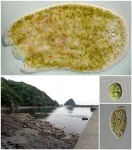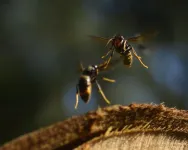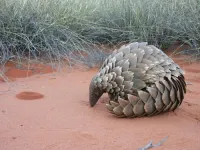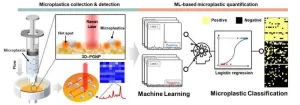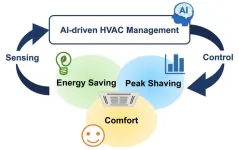(Press-News.org) HOUSTON – (Oct. 5, 2023) – An interdisciplinary team of Rice University scientists has won a $1.9 million National Science Foundation grant for research on materials that could serve as the basis for next-generation energy-efficient computing devices.
The team ⎯ led by Kaiyuan Yang and including co-investigators Ramamoorthy Ramesh, Yimo Han, Douglas Natelson, Shengxi Huang and Lane Martin ⎯ will focus on multiferroics, materials with distinctive electric and magnetic properties that carry “transformative technological potential,” said Ramesh, who is a leading expert in the field. Specifically, the researchers will seek to leverage the spin and charge of electrons in multiferroics in order to process and store information.
The project is supported by the NSF Future of Semiconductors (FuSe) program through a public-private partnership between the NSF and four leading technology corporations. The FuSe initiative aims to “enable rapid progress in new semiconductor technologies and manufacturing as well as workforce development,” according to the agency’s website.
“By 2030, about 25% of global energy demand will come from electronics ⎯ that’s a pretty huge number,” said Ramesh, Rice’s executive vice president for research and professor of materials science and nanoengineering and of physics and astronomy. “With this FuSe grant, our goal is to lower energy consumption for computing. We put together a perfect team to help push the limits of the science and take significant strides toward actually making these low-energy computing devices a reality.”
Rice’s project, titled “Ultra-Low-Energy Logic-in-Memory Computing using Multiferroic Spintronics,” is one of 24 research and education projects funded under the $45.6 million initiative, which includes funding from the 2022 CHIPS and Science Act ⎯ keystone bipartisan legislation that aims to secure a leading role for the U.S. in numerous technological fields including nanotechnology, quantum computing, artificial intelligence and clean energy.
“Existing computing devices are based on silicon and complementary metal-oxide-semiconductor (CMOS) chips,” Yang said. “This technology has major limitations that lead to high energy consumption and limited throughput for large-scale artificial intelligence (AI) computing and massive data mining applications. One of these limitations is that all CMOS-based semiconductor devices generate a certain amount of thermal noise (random heat).”
Lowering operating voltage is the prerequisite to improving these devices’ energy consumption, but the technology is facing an impasse.
“You cannot lower your operating voltage below a certain value, or your signal will get drowned out in that thermal noise,” said Yang, an associate professor of electrical and computer engineering.
Another major limitation in current mainstream processors is that computing and memory tasks are performed separately, leading to major inefficiencies.
“Most of the time, you’re just moving information back and forth between where memory is stored and where logic operations take place,” Ramesh said. “Up to 70% of the energy consumed is squandered in this transfer. Imagine needing to move funds between bank accounts in New York and, say, Zurich every few hours ⎯ you’d lose so much in commissions you could go broke.”
The hope is that multiferroics-based devices would not only improve computing energy efficiency by as much as three orders of magnitude, but that it would also enable a seamless integration of memory and logic functions.
“A single device could simultaneously be both a memory cell and a computing gate,” said Yang, whose expertise is rooted in circuit design and processing architectures. “I will help lead the knowledge derived from fundamental research on multiferroics toward an actual computing application.”
In order for that to happen, the team will work on gaining an in-depth understanding of multiferroics.
Huang, an associate professor of electrical and computer engineering, plans to use high-throughput, noninvasive methods to characterize the materials, their interfaces and the devices made from them.
“I will work closely with the PIs on material synthesis, atomic characterization and device fabrication to achieve the goal of multiferroic spintronic devices and systems,” said Huang, who hopes such materials and devices will play a part in overcoming energy bottlenecks in current mainstream technologies.
Han, an assistant professor of materials science and nanoengineering, will perform advanced, atomic-level imaging to help improve and debug the material.
“Low-power computing is a very important direction for the semiconductor industry to pursue, and we’re developing the materials that will enable it to do so,” said Han, who emphasized the timeliness and urgency of the research by noting that the energy needed to train an AI-powered language model like ChatGPT could power the city of Houston for a whole year.
Natelson, whose research group will help with the device fabrication and electrical measurements of the multiferroics’ critical properties, said the “top notch combination of people and expertise” will hopefully find creative ways to “combine logic and memory in individual devices that operate at much lower voltages than present technologies.”
“It’s great that the Rice team has been selected to be part of this important program,” said Natelson, a professor of physics and astronomy. “This is an opportunity to have a major impact on this urgent technical need while doing some excellent basic research.”
Team members span a broad range of expertise from fundamental materials research to device physics to circuit design and architectures, showcasing a core Rice strength of working across disciplinary boundaries and fueling innovation through collaboration.
“Real problems are at the boundaries between research fields,” said Martin, who leads the Rice Advanced Materials Institute (RAMI) ⎯ one of a constellation of recent university initiatives intended to foster research collaboration and accelerate innovation. “No single person could take on what is truly an existential challenge for the computing field, so we’ve put together a great combination of people across different programs and departments.”
The institute led by Martin will be housed in the Ralph S. O’Connor Building for Engineering and Science, a landmark new research facility the university hopes will attract and retain talented faculty and graduate students with its customizable, cutting-edge labs and amenities.
“In a sense, RAMI is the embodiment of the collaborative, interdisciplinary spirit that brought this team together,” said Martin, Rice’s Welch Professor of Materials Science and Nanoengineering and a professor of physics and astronomy. “The institute seeks to amplify the impact generated by research collaborations such as this one in order to address some of these generational challenges like the limitations of current computing technologies.”
-30-
This release can be found online at news.rice.edu.
Follow Rice News and Media Relations via Twitter @RiceUNews.
Grant information:
https://www.nsf.gov/awardsearch/showAward?AWD_ID=2329111
Image downloads:
https://news-network.rice.edu/news/files/2023/09/230728_Dao_Fitlow_015.jpg
CAPTION: Kaiyuan Yang is an associate professor of electrical and computer engineering at Rice University. (Photo by Jeff Fitlow/Rice University)
https://news-network.rice.edu/news/files/2023/09/230126_Ramesh_Fitlow.jpg
CAPTION: Ramamoorthy Ramesh is Rice’s Executive Vice President for Research and a professor of materials science and nanoengineering and of physics and astronomy. (Photo by Jeff Fitlow/Rice University)
https://news-network.rice.edu/news/files/2023/09/230606_Yimo_Han__Fitlow_472-9.jpg
CAPTION: Yimo Han is an assistant professor of materials science and nanoengineering at Rice University. (Photo by Jeff Fitlow/Rice University)
https://news-network.rice.edu/news/files/2023/09/Shengxi-H-small.jpg
CAPTION: Shengxi Huang is an associate professor of electrical and computer engineering. (Photo courtesy of Shengxi Huang/Rice University)
https://news-network.rice.edu/news/files/2023/09/230404_Lane_Fitlow_001-12.jpg
CAPTION: Lane Martin is Rice’s Welch Professor of Materials Science and Nanoengineering and director of the Rice Advanced Materials Institute (RAMI). (Photo by Jeff Fitlow/Rice University)
https://news-network.rice.edu/news/files/2023/09/image0.jpeg
CAPTION: Douglas Natelson is a professor of physics and astronomy, electrical and computer engineering and materials science and nanoengineering at Rice University. (Photo courtesy of the Natelson research group/Rice University)
Related stories:
NSF backs Rice processor design, chip security research:
https://news.rice.edu/news/2023/nsf-backs-rice-processor-design-chip-security-research
Rice announces commitment to advance interdisciplinary research at new and existing research institutes:
https://news.rice.edu/news/2023/rice-announces-commitment-advance-interdisciplinary-research-new-and-existing-research
Yimo Han wins NSF CAREER Award:
https://msne.rice.edu/news/yimo-han-wins-nsf-career-award
Shengxi Huang Awarded Welch Foundation Grant:
https://www.ece.rice.edu/news/shengxi-huang-awarded-welch-foundation-grant
Rice U. vice president for research named to AAU task force on expanding India partnerships:
https://news.rice.edu/news/2023/rice-u-vice-president-research-named-aau-task-force-expanding-india-partnerships
Rice selects Lane Martin to lead new Advanced Materials Institute:
https://news.rice.edu/news/2023/rice-selects-lane-martin-lead-new-advanced-materials-institute
Ramesh named Rice University’s vice president for research:
https://news.rice.edu/news/2022/ramesh-named-rice-universitys-vice-president-research
Rice Quantum Initiative hires first two faculty:
https://engineering.rice.edu/news/rice-quantum-initiative-hires-first-two-faculty
Links:
Department of Physics and Astronomy: https://physics.rice.edu/
Department of Electrical and Computer Engineering: https://eceweb.rice.edu/
Department of Materials Science and NanoEngineering: msne.rice.edu
Ken Kennedy Institute: https://kenkennedy.rice.edu/
Rice Quantum Initiative: https://quantum.rice.edu/
Smalley-Curl Institute: https://sci.rice.edu/
Bioscience Research Collaborative: https://brc.rice.edu/
Han lab: http://hanlab.blogs.rice.edu/
SCOPE lab: https://scopelab.rice.edu/
Secure and Intelligent Micro-Systems (SIMS) lab: https://vlsi.rice.edu/
Natelson research group: https://natelson.rice.edu/group.html
George R. Brown School of Engineering: https://engineering.rice.edu
Located on a 300-acre forested campus in Houston, Rice University is consistently ranked among the nation’s top 20 universities by U.S. News & World Report. Rice has highly respected schools of Architecture, Business, Continuing Studies, Engineering, Humanities, Music, Natural Sciences and Social Sciences and is home to the Baker Institute for Public Policy. With 4,552 undergraduates and 3,998 graduate students, Rice’s undergraduate student-to-faculty ratio is just under 6-to-1. Its residential college system builds close-knit communities and lifelong friendships, just one reason why Rice is ranked No. 1 for lots of race/class interaction and No. 4 for quality of life by the Princeton Review. Rice is also rated as a best value among private universities by Kiplinger’s Personal Finance.
END
Interdisciplinary Rice team tackles the future of semiconductors
Multiferroics could be the key to ultralow-energy computing
2023-10-05
ELSE PRESS RELEASES FROM THIS DATE:
Researchers design a national testing facility to simulate tornadoes, downbursts and gusts; Experiments will help them engineer buildings that can stand up to extreme winds
2023-10-05
AMES, Iowa – The foundation of a house remains, the basement ripped open and exposed, with the rest of the house blown away. A brick-veneered bank building partially caved in. A collapsed high school gym. Gravestones knocked over. Debris piercing a building.
Partha Sarkar kept hitting next, scrolling through the photo evidence of the destruction he gathered and assessed the day after an EF5 tornado ripped through Parkersburg on May 25, 2008.
Then Sarkar, professor and interim chair of aerospace engineering at Iowa State University, opened a photo showing a house ...
Shining a light on tiny, solar-powered animals
2023-10-05
Acoels have been found to host a wide diversity of symbiotic, photosynthetic microalgae.
Animals and plants need energy. Some animals get energy by eating other animals, and many plants harvest the energy in sunlight through photosynthesis. However, in the ocean, there exists a remarkable group of small, worm-like animals called acoels that do both—some acoels form relationships (symbiosis) with single-celled, photosynthetic microalgae.
A study by Assistant Professor Kevin Wakeman and his undergraduate student, Siratee Riewluang, at Hokkaido University, Japan, has shed some light on the biodiversity underpinning symbiotic relationships between acoels and microalgae. ...
Bumblebees drop to shake off Asian hornets
2023-10-05
Bumblebees have a remarkably successful method for fighting off Asian hornets, new research shows.
When attacked, buff-tailed bumblebees drop to the ground – taking the hornets down with them. This either causes the hornet to lose its grip, or the bee raises its sting and tussles until the hornet gives up.
University of Exeter scientists witnessed over 120 such attacks, and were stunned to find that bumblebees fought off the hornets every time.
Despite this, they found bumblebee colonies had reduced growth rates in ...
AAAS launches STPF Rapid Response Cohort in AI to support policy development in Congress
2023-10-05
The American Association for the Advancement of Science (AAAS) has conceived of and launched a new artificial intelligence (AI) fellowship in just two months — record speed — to support leaders in Congress as they craft legislation, in particular policies related to emerging opportunities and challenges with AI. Capitol Hill’s surging interest in AI policy follows the public release of ChatGPT and other generative AI tools.
The STPF Rapid Response Cohort in AI operates under the AAAS Science & Technology Policy Fellowships (STPF) program and is part of the 51st class of 276 scientists and engineers placed across ...
New research into pangolin genomics may aid in conservation efforts
2023-10-05
A new paper in Molecular Biology and Evolution, published by Oxford University Press, for the first time provides a comprehensive set of genomic resources for pangolins, sometimes known as scaly anteaters, that researchers believe will be integral for protecting these threatened mammals.
Pangolins, which are found in Asia and sub-Saharan Africa, are the only mammals covered in scales. They are trafficked at record numbers for their meat and supposed medicinal properties. The animals are also at risk due to widespread deforestation of their native habitats. Pangolins are made up of eight surviving species ...
Can masculine marketing convince more men to eat vegan?
2023-10-05
Eating more plant-based meals is better for our health and better for the planet. But cultural preferences are significant barriers to reducing meat consumption - especially for men, who are underrepresented among vegans and vegetarians. Studies have found that eating meat is associated with masculinity, and that gender stereotypes label plant-based diets as suitable for women but not men. So is it possible to change the perception of plant-based food with marketing, and convince men to eat more of it?
“Men might be less inclined to consume vegan food due to the need to perform gender,” said Alma Scholz, lead author of a new study published in Frontiers in Communication. ...
Detecting microplastics(MPs) with light!!
2023-10-05
A research team led by Dr. Ho Sang Jung of the Department of Nano-Bio Convergence at the Korea Institute of Materials Science (KIMS), a government-funded research institute under the Ministry of Science and ICT, in collaboration with the KOTITI Testing & Research Institute, has developed the world's first technology to rapidly and highly sensitively detect microplastics(MPs) in the field, which are well known to cause human and genetic toxicity through environmental pollution and the food chain.
The on-site applicable MPs detection technology developed ...
Comfort with a smaller carbon footprint
2023-10-05
Osaka, Japan – As organizations work to reduce their energy consumption and associated carbon emissions, one area that remains to be optimized is indoor heating and cooling. In fact, HVAC – which stands for Heating, Ventilation, and Air Conditioning – represents, on average, about 40% of a building’s total energy use. Methods that conserve electricity while still providing a comfortable indoor environment for workers could make a significant difference in the fight against climate change.
Now, researchers from Osaka University have demonstrated significant energy savings through the application of a new, AI-driven algorithm ...
Study shows enhanced pandemic-related infection prevention and control practices reduced incidence of healthcare-associated infections
2023-10-05
A new study conducted by researchers at The University of Texas MD Anderson Cancer Center suggests that enhanced infection prevention and control (IPC) measures implemented to address the COVID-19 pandemic contributed to a significant decrease in many healthcare-associated infections (HAIs) and a reduction in respiratory viral infections (RVIs). The findings, published today in the American Journal of Infection Control (AJIC), provide some of the first evidence that strict pandemic-related IPC interventions reduced HAI rates among vulnerable patient populations.
“Previous, large-scale ...
New study reveals Australian Long COVID response lagging
2023-10-05
New research by RMIT University and Northern Health has examined Australia’s Long COVID services, guidelines and public health information, compared with international standards.
The researchers found Australia lacking in several categories, including early investigation, accessibility and availability of trustworthy public health information, and adequate multidisciplinary Long COVID services to meet demand.
Dean of RMIT’s School of Health and Biomedical Sciences and co-author on the paper, Professor Catherine Itsiopoulos, warned that this problem will only worsen over time.
“Long ...
LAST 30 PRESS RELEASES:
New study overturns long-held model of how plants coordinate immune responses.
New AI model predicts disease risk while you sleep
Scientists discover molecular ‘reshuffle’ and crack an 80-year-old conundrum
How stressors during pregnancy impact the developing fetal brain
Electrons lag behind the nucleus
From fungi to brain cells: one scientist's winding path reveals how epigenomics shapes neural destiny
Schizophrenia and osteoporosis share 195 genetic loci, highlighting unexpected biological bridges between brain and bone
Schizophrenia-linked genetic variant renders key brain receptor completely unresponsive to both natural and therapeutic compounds
Innovative review reveals overlooked complexity in cellular energy sensor's dual roles in Alzheimer's disease
Autism research reframed: Why heterogeneity is the data, not the noise
Brazil's genetic treasure trove: supercentenarians reveal secrets of extreme human longevity
The (metabolic) cost of life
CFRI special issue call for papers: New Frontiers in Sustainable Finance
HKU Engineering scholar demonstrates the smallest all-printed infrared photodetectors to date
Precision empowerment for brain "eavesdropping": CAS team develops triple-electrode integrated functional electrode for simultaneous monitoring of neural signals and chemical transmitters during sleep
Single-capillary endothelial dysfunction resolved by optoacoustic mesoscopy
HKU three research projects named among ‘Top 10 Innovation & Technology News in Hong Kong 2025’ showcasing excellence in research and technology transfer
NLRSeek: A reannotation-based pipeline for mining missing NLR genes in sequenced genomes
A strand and whole genome duplication–aware collinear gene identification tool
Light storage in light cages: A revolutionary approach to on-chip quantum memories
Point spread function decoupling in computational fluorescence microscopy
BacPhase: Long-insert paired-end sequencing for bin marker construction and genome phasing
GmWOX1 regulates the mediolateral polarity of compound leaves in soybean
ChargeFabrica: An open-source simulation tool that aims to accelerate search for high performance perovskite solar cells
High levels of ADAR overexpression induce abundant and stochastic off-target RNA editing in rice protoplasts
On-demand upgraded recycling of polyethylene and construction of sustainable multifunctional materials based on the "LEGO" strategy
New "Stomata in-sight" system allows scientists to watch plants breathe in real-time
Anorexia nervosa may result in long-term skeletal muscle impairment
Narrative-based performance reviews deemed fairest by employees
New insights reveal how advanced oxidation can tackle emerging water pollutants
[Press-News.org] Interdisciplinary Rice team tackles the future of semiconductorsMultiferroics could be the key to ultralow-energy computing




